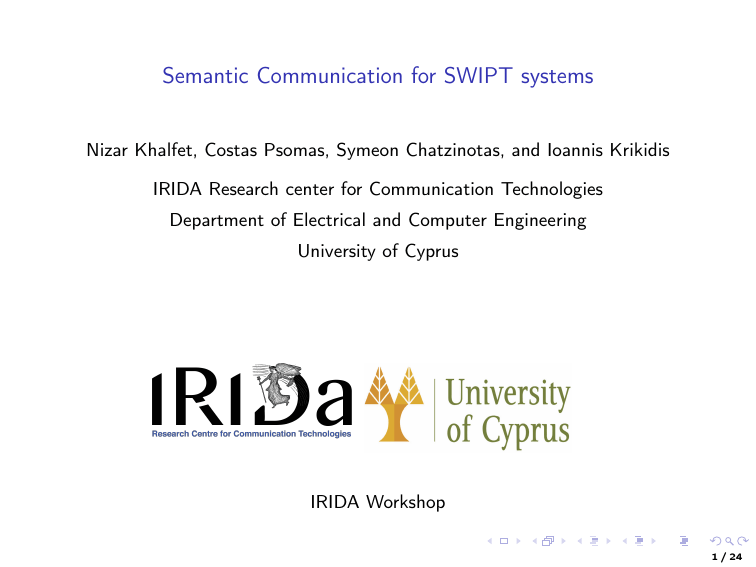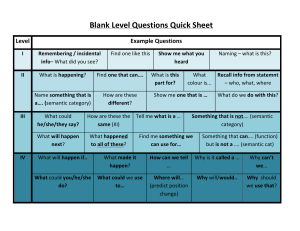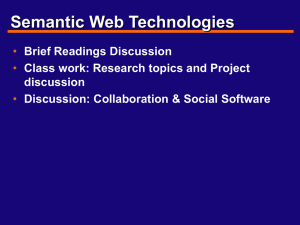
Semantic Communication for SWIPT systems
Nizar Khalfet, Costas Psomas, Symeon Chatzinotas, and Ioannis Krikidis
IRIDA Research center for Communication Technologies
Department of Electrical and Computer Engineering
University of Cyprus
IRIDA Workshop
1 / 24
1
Introduction/Motivation
2
Contributions
3
DM channel with SWIPT and semantics
Achievable region for the DM channel
Converse Semantic information-energy region for DM Channel
4
Gaussian channel with SWIPT and semantics
5
Numerical results
6
Conclusion/Extension
2 / 24
Introduction/Motivation
It is predicted that the global amount of data generated by network nodes will
increase to 175 zetta-bytes in 2025.
SemCom: transmit only the key information to the destination: safely remove the
information irrelevant to the specific task without causing any performance
degradation.
Existing research contributions reveals that SemCom is promising to be used when
the SNR is low and/or the available wireless resource is limited.
SemCom generally requires less power/bandwidth than BitCom.
Introducing SemTrans: enables users to achieve a comparable performance as
BitTrans but consmuing low transmit power, and causing less interference.
2 / 24
Contributions
A novel framework is proposed that enables the study of the fundamental limits of
SWIPT with semantic communication for a discrete memoryless (DM) channel and
a Gaussian channel.
An achievable information-energy region as well its converse for both the DM
channel and the Gaussian channel are characterized by including the semantic
context into the communication.
A higher performance is observed in comparison to conventional communication
approaches (i.e., without semantics) by considering a low semantic ambiguity code.
3 / 24
DM channel with SWIPT and semantics
Semantic channel: P(Q|W )
PY |X
Transmitter
Y
IR
X
PS|X
ER
S
The output y is observed at the receiver, with probability
P(Y = y | X = x) =
n
Y
P(yi |xi ),
(1)
i=1
P(yi |xi ) is the transition probability distribution.
Q: semantic context random variable, with respect to a probability distribution
P(Q|W )
X
P (Q = q|W = w ) = 1.
(2)
q∈Q
4 / 24
DM channel with SWIPT and semantics
Semantic channel: P(Q|W )
PY |X
Transmitter
Y
IR
X
PS|X
ER
S
semantic distance between two words as
d(w , ŵ ) = 1 − sim(w , ŵ ),
(3)
0 ≤ sim(w , ŵ ) ≤ 1: semantic similarity between w and ŵ
the average semantic error denoted by PSE is given by
X
P(Y = y |X = x)
PSE (q) =
w ∈W,q∈Q,y ∈Y n ,x∈X n
×P(Q = q|W = w )P(W = w )d(w , ŵ )
(4)
5 / 24
DM channel with SWIPT and semantics
Semantic channel: P(Q|W )
PY |X
Transmitter
Y
IR
X
PS|X
ER
S
The output s at the EH is observed at the receiver, with probability
P(S = s | X = x) =
n
Y
P(si |xi ),
(5)
i=1
E(s): the average harvested energy function given by
E(s) =
n
1X
g (si ),
n i=1
(6)
g : S → R+ : the energy harvested from the output symbols.
6 / 24
DM channel with SWIPT and semantics
Semantic channel: P(Q|W )
PY |X
Transmitter
Y
IR
X
PS|X
ER
S
Achievable rates
From a semantic communication standpoint, an information-energy rate (R, b) is
achievable, if the probability of the miss-interpretation of message w , given the context
Q, PSE , satisfies the limit PSE (q) → 0, for n → ∞ and the energy shortage probability,
PES (b) satisfies PES [E(y ) ≤ b] → 0, for n → ∞.
7 / 24
Achievable region for the DM channel
Semantic Information energy achievable region
The information energy capacity in the case of non-colocated EH is upper bounded by
the function C : [b1 , b0 ] → R+ , is
C(b) ≥
max
ρ.P(X |W )|E(y )≥b
I (X ; Y ) − H(X |W ) + H(Q),
I (X ; Y ) = H(X ) − H(X |Y ) is the mutual information between X and Y .
H(X |W ) is the equivocation of the semantic encoder, given the semantic context Q.
H(Q) measures the semantic context source, or the local information available at
the transmitter and receiver.
A higher H(Q) means strong ability of the receiver to interpret received messages.
8 / 24
Proof of Achievable region: Jointly typical sequences
Definition
Let An jointly typical sequences {(x n , y n )} with respect to p(x, y ) is the set of n
sequences with empirical entropy close to the true entropies, i.e.,
An = {(x n , y n )} ∈ X n × Y n :
1
− log p(x n ) − H(X ) < n
1
− log p(y n ) − H(Y ) < n
1
− log p(x n , y n ) − H(X , Y ) < n
p(x n , y n ) =
Qn
i=1
(7)
(8)
(9)
(10)
p(xi , yi )
9 / 24
Proof of Achievable region: Jointly typical sequences
Theorem
P{(X n , Y n ) ∈ An } → 1 as n → ∞
|An | ≤ 2n(H(X ,Y )+)
if (X n , Y n ) has a distribution p(x n )p(y n ) then
P{(X n , Y n ) ∈ An } ≤ 2n(I (X ;Y )−3)
(11)
10 / 24
Proof of the Achievable region
A semantic error appears if a received message is not decoded by the receiver using
the context Q.
Let n be sufficiently large number, Q1 , Q2 , . . . , QN is the sequence of the observed
context, X1 , X2 , . . . , XN is the sequence of the transmitted signals, Y1 , X2 , . . . , XN is
the sequence of the received signals.
According to AEP: there are 2nH(Q) typical sequence of context
According to AEP: and the channel coding Theorem : there are 2(I (X ;Y )−R)N typical
input sequence.
According to AEP: there are 2−NH(X |W ) typical sequence of X given the context.
Hence there are : 2(I (X ;Y )−H(X |W )+H(Q))N typical sequence of input given the context.
11 / 24
Converse region for the DM channel
Semantic Information energy converse region
The information energy capacity in the case of non-colocated EH is upper bounded by
the function C : [b1 , b0 ] → R+ , is
X
C(b) ≤
max
H(X ) − H(X |W ) − H(X |W , Y ) +
p(W )H(Q|W )
ρ.P(X |W )|E (ρ)≥b
W
12 / 24
Sketch of the Proof
By using Fano inequality:
NR ≤
N
X
NI (Xi ; Yi ) + o(N)
(12)
i=1
X , Y and W are random variables such that W → X → Y that form a Markov
chain, i.e., W and Y are independent given X
I (Y ; W |X ) = 0.
(13)
I (X ; W ) ≥ I (Y ; W )
(14)
Data procession inequality, i.e,
13 / 24
SWIPT Gaussian channel with semantics
Semantic channel: P(Q|W )
zt
Transmitter
xt
⊗
h1
⊕
y1,t
IR
h2
y2,t
ER
Information Decoder: y1,t = h1 xt + zt ,
Energy harvester:
y2,t = h2 xt
zt ∼ N (0, 1) is the Gaussian noise with unit variance.
The conditional probability:
(y − h1 x 2 )
1
p(y |x) = √ exp −
.
2
2π
(15)
14 / 24
SWIPT Gaussian channel with semantics
Semantic loss for the Guassian case by using the maximum likelihood (ML) detector:
s
n
n
kxi − xj k2
1X X
,
(16)
PSE (q) =
d(xi , xj )Q P
n i=1
2
j=1,j6=i
d(xi , xj ) = 1 − sim(xi , xj )
sim(xi , xj ) =
BΦ (mi )BΦ (mj )T
,
kBΦ (mi )k kBΦ (mj )k
(17)
BΦ (·) : the pretrained bidirectional encoder representation from transformers
(BERT) model
The average harvested energy:
E(Y2 ) =
n
1X 2
Y2,t .
n t=1
(18)
15 / 24
Gaussian channel with SWIPT and semantics
Semantic channel: P(Q|W )
zt
Transmitter
xt
⊗
h1
⊕
y1,t
IR
h2
Y2,t
ER
Achievable region for Gaussian channel
The information energy capacity is lower bounded by the function C : R+ → R+ , is
C(b) ≥
max
P(X |W )|E(Y2 )≥b
1
log(1 + λ1 P) − h(X |W )
2
1
+ log(1 + λ2 P),
2
(19)
where λ1 ≥ 0 and λ2 ≥ 0 denotes the fraction of the power dedicated to the information
signal component and the semantic context signals, respectively.
16 / 24
Proof of the achievable region for the Gaussian channel
Context random variable satisfies, Q ∼ N (0, λ2 P) and X ∼ N (0, λ1 P)
λ1 + λ2 = 1,
(20)
Codewords are chosen to be i.i.d, with variance P − and satisfies
E[I0 (Bh2 |Xi |)] = b + .
The context Q is sent through a feedback link using a faction λ2 of the power P.
The receiver observes the codeword list and the sequence of the context
Q1 , Q2 , . . . , Qn generated via feedback by the transmitter, and decides on w if
{X n (w ), Y } are jointly typical, {Q n (w )} is a typical sequence, and
{X n (w )|W } is a typical sequence given the context.
using the AEP, the semantic error probability is upper bounded as follows
PSE ≤ 2N(−I (X :Y )+H(X |Q)−H(Q)−3) ,
(21)
17 / 24
Gaussian channel with SWIPT and semantics
Semantic channel: P(Q|W )
zt
Transmitter
xt
⊗
h1
⊕
y1,t
IR
h2
Y2,t
ER
Converse region for Gaussian channel
The information-energy capacity region for the SWIPT semantic communication is upper
bounded by the function C : R+ → R+ , i.e.,
C(b) ≤ max
1
E(Y2 )≥b 2
log(1 + µ1 Preq ) +
1
log(1 + µ2 Preq ),
2
where µ1 ≥ 0 and µ2 ≥ 0 denote the fraction of the power dedicated to the input X and
the semantic context Q, respectively.
18 / 24
Proof of the converse region for the Gaussian channel
From the assumption that the message indice W ∈ {1, 2, . . . , 2nR } are i.i.d.
following a uniform distribution,and using Fano’s inequality
nR = H(W ) = I (W ; Ŵ ) + H(W |Ŵ )
n
X
≤
h(Yi |Qi ) − h(Z ) + n,
(22)
(23)
i=1
→ 0 as PSE → 0.
By using a power splitting technique between the information component and the
semantic context Q, i.e.,
Y = µ1 X + µ2 Q + Z ,
(24)
µ1 + µ2 = 1.
By applying Jensen’s inequality, we obtain
R≤
1
1
log(1 + µ1 P) + log(1 + µ2 P).
2
2
(25)
19 / 24
Example: Semantic through binary symmetric channel
Binary symmetric channel (BSC) with a crossover probability of ρ
p(Y = y | X = x) = ρl(y,x) (1 − ρ)n−l(y,x)
(26)
l(y, x) is the Hamming distance between y and x.
Two sets of contexts Q = {q1 , q2 }
q1 = things originating from non-living beings
q2 = things originating from living beings.
1,
P(Q = q1 |W = w ) = 0,
0.5.
E (ρ) =
if w = car,automobile
if w = bird
if w = Crane
(27)
n
1X
[(1 − ρ)P(xn = 1) + ρP(xn = 0)]b1
n n=1
+[ρP(xn = 1) + (1 − ρ)P(xn = 0)]b0 ,
(28)
20 / 24
Numerical results: Achievable semantic information-energy region versus
converse region over a DM channel
21 / 24
Achievable semantic information-energy region versus conventional capacity
over a DM channel
22 / 24
Impact of semantic context on the information-energy capacity region over
the Gaussian channel
23 / 24
Conclusion/Extension
For the point-to-point case, we have developed an information theoretic framework
to characterize achievable information-energy regions and their converses,
considering both the DM and the Gaussian channels.
Numerical results indicate that employing low semantic ambiguity codes can lead to
improved performance compared to conventional communication approaches.
Extension: The Gaussian MAC case has been considered: A system with a semantic
transmitter and a conventional transmitter, operating under EH constraints at the
receiver has been considered.
24 / 24





